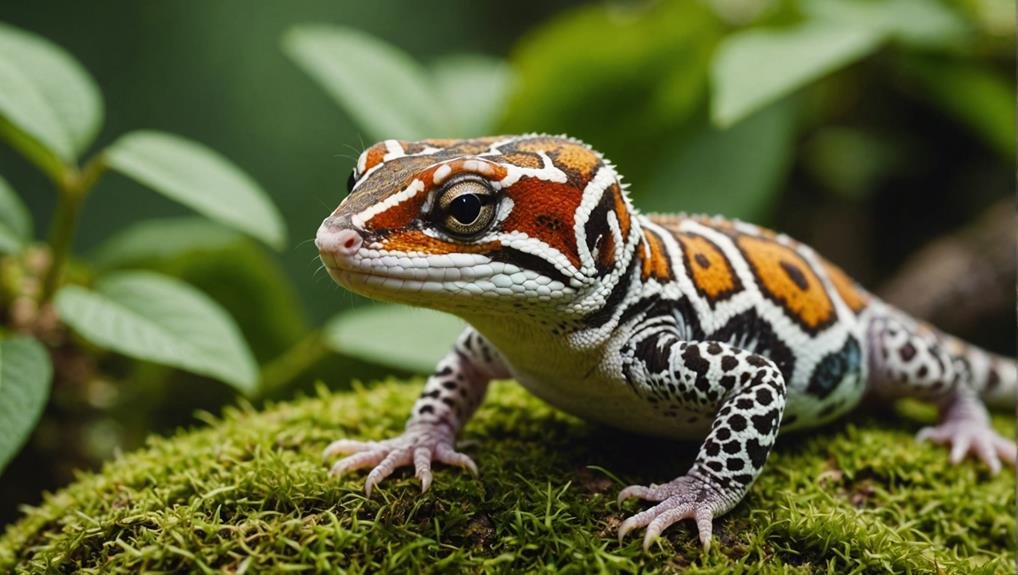When you first bring a baby leopard gecko home, you’ll quickly notice their fascinating yet cautious nature. These hatchlings, often displaying defensive behaviors like hissing and biting, need a carefully set habitat to thrive. To guarantee your well-being, you must pay close attention to heating, humidity, and nutrition. Creating a moist hide and establishing a daily care routine is just the beginning. But how do you handle them without causing stress, and what are the key signs to monitor for health issues? Let’s explore these aspects to help you raise a healthy and happy gecko.
Key Takeaways
- Hatchling behavior: Baby leopard geckos may hiss, screech, and bite when handled, showing fear and defensiveness.
- Habitat: For comfort and safety, use a 10′ x 8′ x 6′ tank with a heat mat, hides, and kitchen roll substrate.
- Temperature: Maintain a temperature gradient with a heat mat, aiming for around 88°F.
- Feeding: Provide a variety of gut-loaded insects dusted with calcium powder for balanced nutrition and bone health.
- Shedding: Ensure a moist hide to assist with shedding and monitor that all skin, especially around toes and tail, is properly shed.
Hatchling Behavior
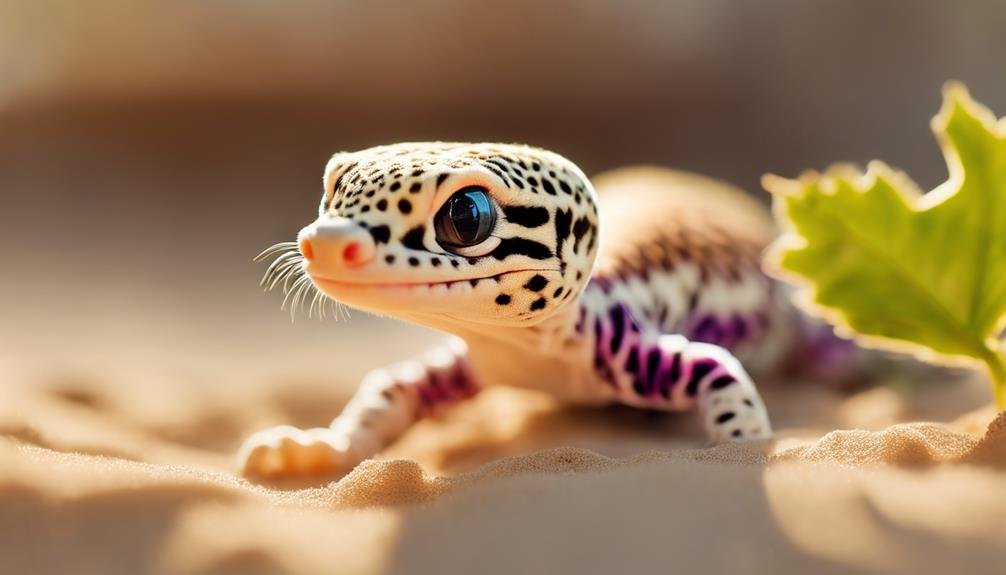

Upon hatching, baby leopard geckos often exhibit defensive behaviors like hissing, screeching, and biting. These behaviors are natural responses to their new environment and are typical hatchling behavior. Don’t be alarmed if your hatchling seems more like a tiny, fierce dragon than a gentle gecko at first. It’s their way of asserting themselves and trying to feel secure.
You should leave the hatchlings in the incubator for about 12 hours after they hatch. This gives them time to recover from the hatching process and helps reduce stress. During this period, you might notice them digging in their incubation box. This is another normal aspect of hatchling behavior as they explore their surroundings and get comfortable.
Expect your hatchlings to show fear and defensive reactions when you handle them. It’s important to remain calm and gentle. Your steady, non-threatening approach will help them gradually become accustomed to human interaction. Remember, patience is key.
Initial Habitat Setup
To set up your baby Setup gecko’s habitat, start with a 10′ x 8′ x 6′ container to guarantee enough space.
Place a heat mat underneath one end to maintain a warm side at around 88°F.
Don’t forget to add hides at both ends and use the kitchen roll as a safe substrate.
Choosing Appropriate Tank Size
The appropriate tank size for your baby leopard gecko is essential for its comfort and well-being. Baby leopard geckos thrive in an environment that’s just the right size, typically around 10 inches long, 8 inches wide, and 6 inches high. This site provides ample space for exploration and growth without overwhelming the tiny reptile.
You’ll need enough room in the tank to place hides, a water dish, and other essentials. Ensuring the baby gecko can easily find these items is vital for health. If the tank is too large, it might cause unnecessary stress and make it difficult for the gecko to establish territories and thermoregulate properly.
On the other hand, a tank that’s too small can lead to cramped conditions, affecting the gecko’s ability to move freely and comfortably. Starting with an appropriately sized enclosure helps prevent stress and inadequate thermoregulation.
Setting Up Heating Elements
An important step in setting up your baby leopard gecko’s habitat is ensuring proper heating elements are in place. Heat mats are an excellent choice, providing belly heat that mimics the sun’s warmth on the gecko’s stomach. Always use a thermostat to ensure the heat mat doesn’t get too hot. This device will regulate the temperature, keeping the environment safe and comfortable for your gecko.
Position the heat mat at one end of the enclosure. This creates a temperature gradient, allowing your gecko setup to thermoregulate effectively between warmer and cooler areas. Temperature monitoring is essential; aim to maintain the warm side around 88°F. Use a reliable thermometer to check this regularly.
Here are some essential points to take into account:
- Use a heat mat: Provides belly heat similar to the sun’s warmth.
- Install a thermostat: Regulates the temperature, preventing overheating.
- Create a temperature gradient: Position the heat mat on one end of the enclosure.
- Monitor with a thermometer: Ensure the warm side stays around 88°F.
Avoid using heat rocks, as they can cause burns and injuries. Stick to safer options like heat mats to ensure your baby leopard gecko thrives in its new home.
Moist Hide Creation
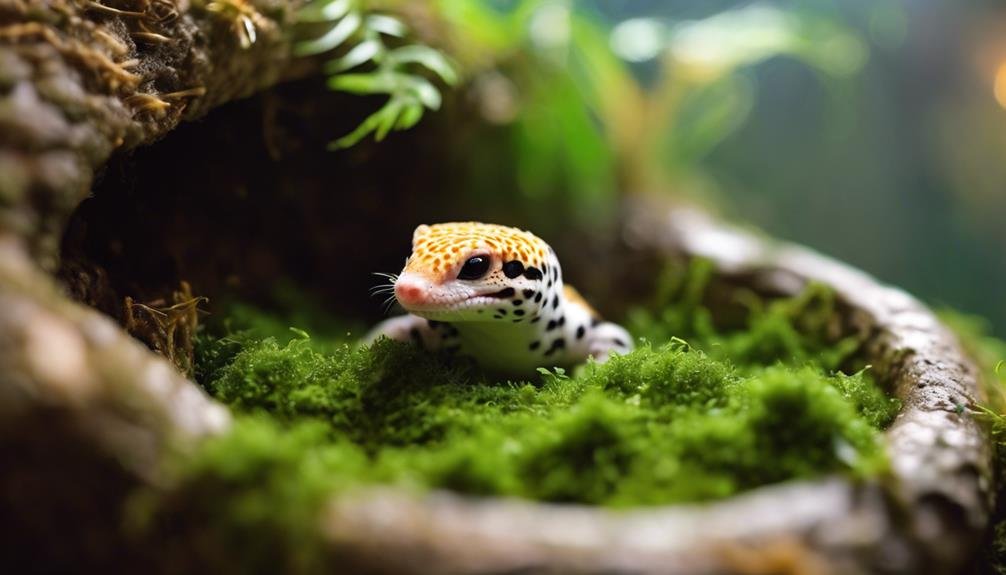

To create a moist hide for your baby leopard gecko, you’ll need a waxworm tub and a damp kitchen roll to maintain humidity.
Make sure the tub has no sharp edges to keep your hatchling safe.
This setup guarantees ideal humidity, providing a secure and comfortable parking spot for your baby gecko.
Choosing Appropriate Materials
It is vital to use repurposed waxworm tubs to create a moist hide for your baby leopard gecko. Start by cleaning out the tub thoroughly to remove any residue.
Next, line the inside with a damp kitchen roll, ensuring it’s moist but not soaking wet. The humid hide helps maintain the humidity levels essential for your baby leopard gecko’s well-being.
Before placing the tub in the enclosure, check for sharp edges. Smooth them out with sandpaper or a file to guarantee the safety of your hatchling.
Providing a suitable hiding spot is critical for baby leopard geckos’ overall health and comfort. It gives them a sense of security and aids in their shedding process.
Here’s a quick checklist to guide you:
- Clean the waxworm tub: Ensure it’s free from residue or contaminants.
- Add damp kitchen roll: Make sure it’s moist and not dripping.
- Smooth out sharp edges: Use sandpaper or a file to eliminate potential hazards.
- Position in the enclosure: Place the moist hide in a quiet, accessible corner.
Maintaining Optimal Humidity
Ensuring ideal humidity levels is essential for your baby leopard gecko’s health and development. One effective way to maintain these levels is by creating a moist hide. A damp hide offers a secure and humid environment where your hatchlings can retreat when needed, helping to keep their skin healthy and aiding in shedding.
You can repurpose everyday items like waxworm tubs to create a moist hide. Line the tub with a damp kitchen roll or moistened paper towels. This setup is simple and effective, making it a convenient solution for ensuring the best humidity.
Placsetup moist hide inside your gecko’s enclosure, ideally on the warm side, to create a balanced microhabitat.
Proper humidity is essential for baby leopard geckos because it helps prevent dehydration and promotes successful shedding. Without adequate moisture, your gecko might face health issues such as retained shed skin, which can cause discomfort and potential infections.
Transferring to New Home
Your baby leopard gecko’s move to its new home should be handled carefully to guarantee a stress-free shift. Avoid handling your gecko excessively to ensure a smooth change. This will reduce stress and help the gecko settle in comfortably.
The best way to transfer your baby leopard gecko is by moving the entire incubation container into its new habitat. This minimizes disturbances and makes the shift easier for your pet.
Once in their new home, allow your baby leopard gecko to adjust quickly. Rushing the process can cause unnecessary stress. Placing the container on a heat mat can help maintain the ideal temperature in their new environment. This is essential for their well-being and comfort.
Here are some tips to make the transfer process smoother:
- Minimize Handling: Handle your gecko as little as possible during the move.
- Use Incubation Container: Move the entire incubation container to reduce disturbances.
- Temperature Control: Place the container on a heat mat to maintain the right temperature.
- Allow Adjustment: Give your gecko time to explore and acclimate to their new surroundings without interruptions.
Daily Care Routine
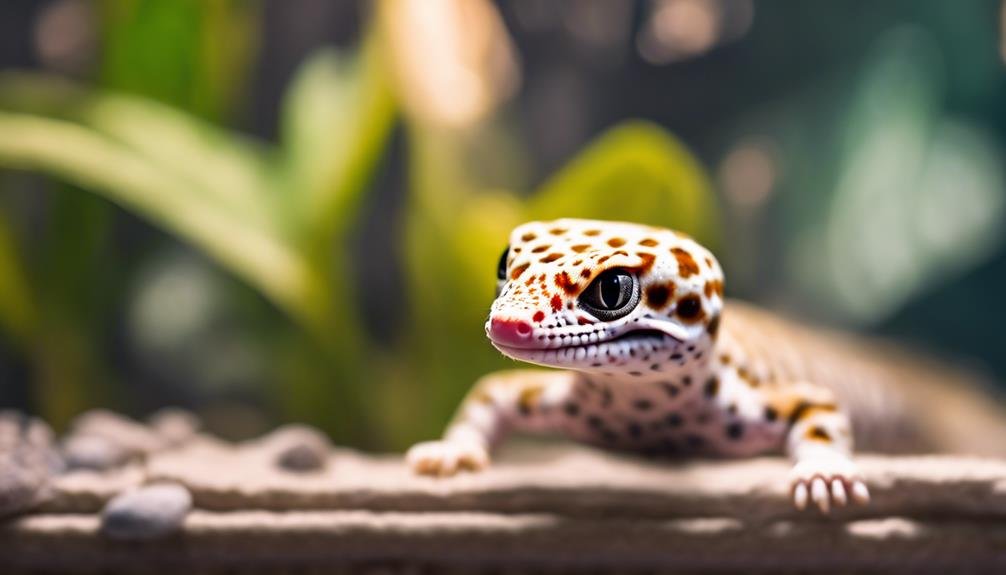

Establish a consistent feeding schedule with various sized live insects to keep your baby leopard gecko healthy. Also, the habitat must be regularly maintained by checking the temperature and ensuring clean water is available.
Monitor health indicators like appetite and shedding to catch any potential issues early.
Feeding Schedule Tips
Consistently feed your baby leopard gecko daily with various gut-loaded, calcium-dusted insects to support its growth. Establishing a proper feeding schedule is essential for their development. Offer insects like crickets, silkworms, and dubia roaches, ensuring they’re no larger than the space between your gecko’s eyes to prevent choking hazards.
Here are some tips to enhance your feeding routine:
- Variety: Rotate the types of insects you offer to provide a balanced diet and prevent boredom.
- Gut-loading: Feed the insects nutritious foods 24 hours before giving them to your gecko to ensure they’re packed with essential nutrients.
- Calcium Dusting: Dust the insects with a calcium powder before feeding to support bone health and prevent metabolic bone disease.
- Observation: Monitor your gecko’s weight and growth, adjusting the quantity of food as needed to avoid overfeeding or underfeeding.
Incorporate these tips into your daily care routine.
Also, always provide a shallow dish of calcium powder in the enclosure for your baby gecko to self-regulate its calcium intake.
Habitat Maintenance Essentials
Maintaining a clean and comfortable habitat for your baby leopard gecko involves daily tasks guaranteeing its well-being and health. Start by spot-cleaning the enclosure to remove any faces or uneaten food. This prevents bacterial growth and keeps the habitat sanitary.
Next, check and refill the water dish daily to guarantee your gecko stays hydrated, especially since they rely on this for moisture.
Monitor the temperature and humidity levels in the enclosure every day. Leopard geckos need a warm, dry environment, but slight humidity helps when they shed their skin. Use a thermometer and hygrometer to keep track of these conditions, adjusting as necessary.
Inspect the substrate for cleanliness. Replace it as needed to maintain a fresh environment and avoid any bacterial buildup that could harm your gecko.
Provide fresh food daily, adjusting portion sizes based on your baby gecko’s appetite. Keeping their diet consistent and nutritious is key to their growth and development.
Monitoring Health Indicators
Daily monitoring of your baby leopard gecko’s health is essential for catching early signs of stress or illness. During your daily interactions, observe any unusual behaviors that could indicate problems, such as lethargy or a loss of appetite. Consistent monitoring guarantees you can address issues promptly, promoting a healthy and active gecko.
Pay close attention to the humidity levels in the enclosure. Aim for 20-40% to prevent skin issues and respiratory problems. Keeping the humidity within this range is necessary for the well-being of your baby leopard gecko.
Another critical aspect is maintaining the correct temperature gradient. Ensure the warm end of the enclosure is around 88°F and the cool end is between 70-75°F. This gradient supports proper thermoregulation, helping your gecko thrive.
Look out for signs of shedding, such as dull skin or cloudy eyes. Providing a moist hide can assist your gecko in shedding successfully, which is essential for skin health.
Make sure to:
- Observe feeding habits: Ensure your baby gecko is eating appropriately-sized prey.
- Check for lethargy: Lack of movement can signal health issues.
- Monitor humidity levels: Maintain 20-40% to prevent skin and respiratory problems.
- Provide a moist hide: Helps with shedding and overall skin health.
Nutritional Needs
To guarantee your baby leopard gecko thrives, provide a diet rich in calcium and vitamins. These nutritional needs are vital for their rapid growth and development.
It would be best to offer appropriately sized insects such as small crickets, silkworms, and small dubia roaches. These insects are perfect for meeting the nutritional needs of your baby gecko.
To further enhance the nutritional value of these feeder insects, gut-load them with nutritious foods like fruits, vegetables, and commercial gut-loading products. This process ensures the insects are packed with essential nutrients before they become your gecko’s meal.
Additionally, always dust the live prey with calcium and vitamin supplements before feeding them to your baby leopard gecko. This step is important in providing the necessary nutrients to support their bone development and overall health.
Providing a varied diet is also essential for preventing nutritional deficiencies. Rotate between different types of feeder insects to ensure your gecko gets a well-rounded intake of nutrients.
Shedding Process
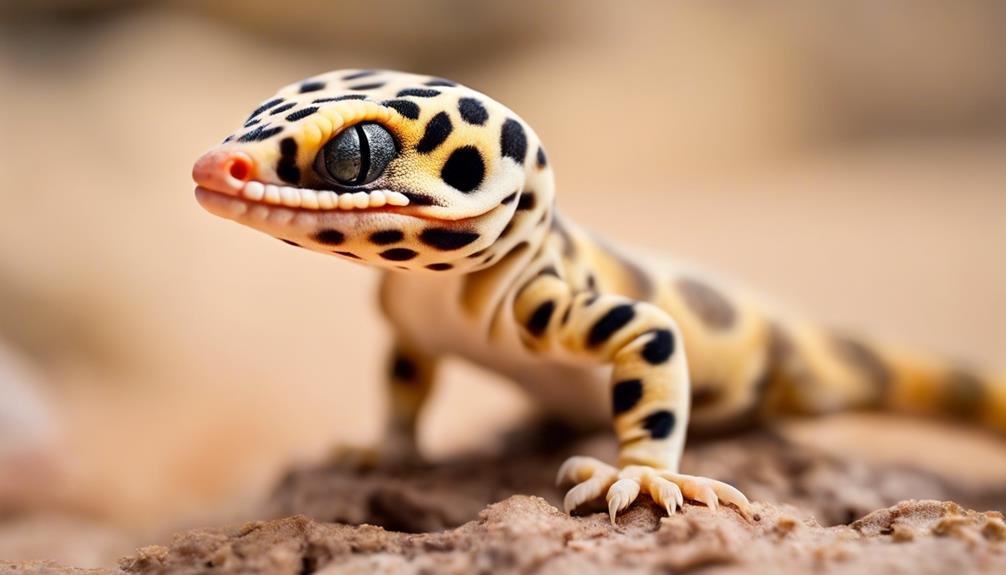

Baby leopard geckos shed their skin frequently every 1-2 weeks to accommodate their rapid growth. This shedding process is vital as it allows them to grow and replace old, damaged skin. You might notice your baby gecko rubbing against objects in their enclosure; this behavior helps them remove the old skin.
To support your gecko’s shedding process, consider providing a moist hide. This increases humidity and makes it easier for them to shed completely. A humid hide can be as simple as a small container with damp moss or paper towels.
It’s also normal for baby leopard geckos to eat their shed skin. This behavior is beneficial as it helps them replenish essential nutrients lost during shedding. Monitor the process to ensure your gecko has shed all its skin, especially on the toes and tail, as retained skin can cause complications.
Here are some tips to aid in the shedding process:
- Provide a moist hide: Increases humidity levels.
- Monitor the shed: Ensure all skin is shed, especially on the toes and tail.
- Offer proper nutrition: Supports overall health and shedding.
- Observe behavior: Rubbing against objects is normal during shedding.
Health Monitoring
Consistently monitoring your leopard gecko’s health guarantees their well-being and prompt detection of potential issues. Start by regularly checking your baby leopard gecko’s weight. A steady increase indicates proper growth and development, while sudden changes could signal health problems.
Ensure your baby leopard gecko stays hydrated. Look for signs of dehydration like sunken eyes or wrinkled skin, and ensure they can access fresh water. Another key aspect is observing the shedding process. It should occur smoothly; any retained shed, especially around the toes, can cause complications.
Behavioral changes can also hint at health issues. If your baby leopard gecko lacks appetite or seems sluggish, it might be a sign they’re not feeling well. Keeping their enclosure clean is equally important. Regularly sanitize the habitat to prevent the buildup of bacteria and parasites that could harm your baby gecko.
Here’s a quick reference table:
| Monitoring Aspect | What to Look For |
|---|---|
| Weight | Steady increase, sudden changes |
| Hydration | Sunken eyes, wrinkled skin |
| Shedding Process | Smooth shedding, no retained shed |
| Behavior | Lack of appetite, lethargy |
| Enclosure Cleanliness | Regular cleaning to avoid bacteria |
Common Issues
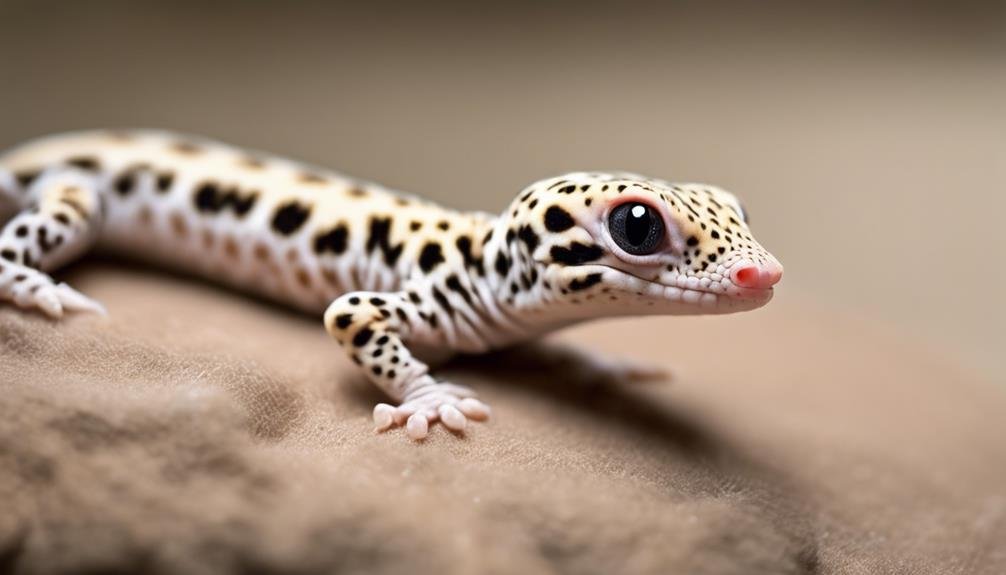

Monitoring your baby leopard gecko’s health helps you catch common issues early on, ensuring prompt and effective care. One common problem is shedding difficulties. Hatchlings sometimes struggle with this process, so providing a moist hide is essential.
Another issue is dehydration. Baby leopard geckos need constant access to fresh water to stay hydrated.
Here are some common issues and how to address them:
- Shedding Problems: Make sure a moist hide is available to help them shed properly.
- Dehydration: Keep fresh water accessible at all times.
- Stress: Improper handling and inadequate temperature gradients can cause anxiety. Follow care sheets to create a suitable environment.
- Illness Signs: Lethargy, loss of appetite, or abnormal faces are red flags. Consult a vet if you notice these symptoms.
Inadequate hides, substrate, and enrichment can also lead to behavioral issues, impacting your gecko’s overall well-being. Ensure you provide an environment that meets their needs as outlined in care sheets.
Handling Tips
Handling your baby leopard gecko with care is essential to ensure their safety and comfort. Be gentle and slow when interacting with your new baby to prevent stress. Support their entire body properly to avoid injury or discomfort. Always use both hands, letting the gecko rest on your palm while gently supporting their body with your fingers.
Begin handling sessions gradually. Short, calm interactions will help your baby leopard gecko get accustomed to human contact. Over time, you can increase the duration as they become more comfortable. Avoid sudden movements or loud noises, which can startle your gecko and make you anxious. A peaceful environment is essential for successful handling.
Remember to wash your hands before and after each handling session. This practice prevents the transfer of harmful bacteria or chemicals that could affect your gecko’s health. Clean hands ensure you and your new baby stay safe during these bonding moments.
Conclusion
Caring for a baby leopard gecko means being attentive to its unique needs and creating a safe, comfortable environment. By setting up the right habitat, monitoring health, and handling with care, you’ll help your little gecko thrive.
Remember, patience and consistency are key. With proper care and attention, your baby leopard gecko will grow into a healthy, happy pet, bringing joy to your reptile-keeping experience.
FAQs
1. What Does a Baby Leopard Gecko Eat?
It would be best to feed them small insects like crickets, silkworms, and dubia roaches. Maintain a varied diet for balanced nutrition: gut-load and dust prey with supplements. Stick to a consistent feeding schedule for best health.
2. Do Baby Leopard Geckos Like to Be Held?
They don’t usually like to be held due to natural fear. Keep handling frequency low to minimize stress. Once settled, consistent and gentle handling can help them become more comfortable, but always be cautious as they’re quite fast.
3. Can You Handle Baby Leopard Geckos?
Yes, you can handle them. Use these handling tips: be gentle and patient, let them settle in first, and avoid overhandling to prevent stress. Regular, gentle handling helps them become comfortable with human interaction.
4. How Big Is a 3-Month-Old Leopard Gecko?
At three months old, they measure around 3 to 4 inches. For a size comparison, think of a small crayon. Monitoring their rapid growth during this period is essential, as they typically weigh 10 to 15 grams.
Related Article:
https://thereptileguide.com/guinea-pigs/
https://thereptileguide.com/chameleon-facts/

